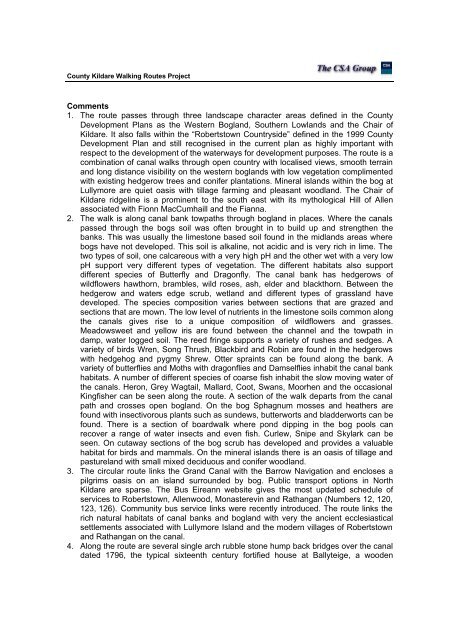County Kildare Walking Routes Project - Kildare.ie
County Kildare Walking Routes Project - Kildare.ie
County Kildare Walking Routes Project - Kildare.ie
You also want an ePaper? Increase the reach of your titles
YUMPU automatically turns print PDFs into web optimized ePapers that Google loves.
<strong>County</strong> <strong>Kildare</strong> <strong>Walking</strong> <strong>Routes</strong> <strong>Project</strong><br />
Comments<br />
1. The route passes through three landscape character areas defined in the <strong>County</strong><br />
Development Plans as the Western Bogland, Southern Lowlands and the Chair of<br />
<strong>Kildare</strong>. It also falls within the “Robertstown Countryside” defined in the 1999 <strong>County</strong><br />
Development Plan and still recognised in the current plan as highly important with<br />
respect to the development of the waterways for development purposes. The route is a<br />
combination of canal walks through open country with localised v<strong>ie</strong>ws, smooth terrain<br />
and long distance visibility on the western boglands with low vegetation complimented<br />
with existing hedgerow trees and conifer plantations. Mineral islands within the bog at<br />
Lullymore are qu<strong>ie</strong>t oasis with tillage farming and pleasant woodland. The Chair of<br />
<strong>Kildare</strong> ridgeline is a prominent to the south east with its mythological Hill of Allen<br />
associated with Fionn MacCumhaill and the Fianna.<br />
2. The walk is along canal bank towpaths through bogland in places. Where the canals<br />
passed through the bogs soil was often brought in to build up and strengthen the<br />
banks. This was usually the limestone based soil found in the midlands areas where<br />
bogs have not developed. This soil is alkaline, not acidic and is very rich in lime. The<br />
two types of soil, one calcareous with a very high pH and the other wet with a very low<br />
pH support very different types of vegetation. The different habitats also support<br />
different spec<strong>ie</strong>s of Butterfly and Dragonfly. The canal bank has hedgerows of<br />
wildflowers hawthorn, brambles, wild roses, ash, elder and blackthorn. Between the<br />
hedgerow and waters edge scrub, wetland and different types of grassland have<br />
developed. The spec<strong>ie</strong>s composition var<strong>ie</strong>s between sections that are grazed and<br />
sections that are mown. The low level of nutr<strong>ie</strong>nts in the limestone soils common along<br />
the canals gives rise to a unique composition of wildflowers and grasses.<br />
Meadowsweet and yellow iris are found between the channel and the towpath in<br />
damp, water logged soil. The reed fringe supports a var<strong>ie</strong>ty of rushes and sedges. A<br />
var<strong>ie</strong>ty of birds Wren, Song Thrush, Blackbird and Robin are found in the hedgerows<br />
with hedgehog and pygmy Shrew. Otter spraints can be found along the bank. A<br />
var<strong>ie</strong>ty of butterfl<strong>ie</strong>s and Moths with dragonfl<strong>ie</strong>s and Damselfl<strong>ie</strong>s inhabit the canal bank<br />
habitats. A number of different spec<strong>ie</strong>s of coarse fish inhabit the slow moving water of<br />
the canals. Heron, Grey Wagtail, Mallard, Coot, Swans, Moorhen and the occasional<br />
Kingfisher can be seen along the route. A section of the walk departs from the canal<br />
path and crosses open bogland. On the bog Sphagnum mosses and heathers are<br />
found with insectivorous plants such as sundews, butterworts and bladderworts can be<br />
found. There is a section of boardwalk where pond dipping in the bog pools can<br />
recover a range of water insects and even fish. Curlew, Snipe and Skylark can be<br />
seen. On cutaway sections of the bog scrub has developed and provides a valuable<br />
habitat for birds and mammals. On the mineral islands there is an oasis of tillage and<br />
pastureland with small mixed deciduous and conifer woodland.<br />
3. The circular route links the Grand Canal with the Barrow Navigation and encloses a<br />
pilgrims oasis on an island surrounded by bog. Public transport options in North<br />
<strong>Kildare</strong> are sparse. The Bus Eireann website gives the most updated schedule of<br />
services to Robertstown, Allenwood, Monasterevin and Rathangan (Numbers 12, 120,<br />
123, 126). Community bus service links were recently introduced. The route links the<br />
rich natural habitats of canal banks and bogland with very the anc<strong>ie</strong>nt ecclesiastical<br />
settlements associated with Lullymore Island and the modern villages of Robertstown<br />
and Rathangan on the canal.<br />
4. Along the route are several single arch rubble stone hump back bridges over the canal<br />
dated 1796, the typical sixteenth century fortif<strong>ie</strong>d house at Ballyteige, a wooden
















